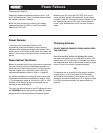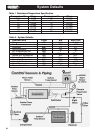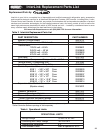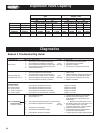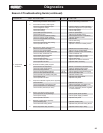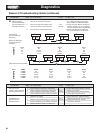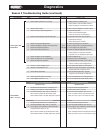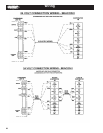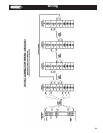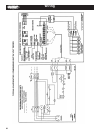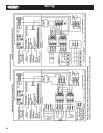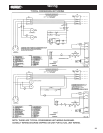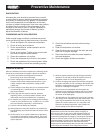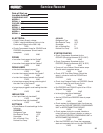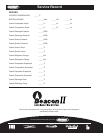
34
EVAPORATORS
All evaporator units should be checked once a month
or more often for proper defrosting because the amount
and pattern of frosting can vary greatly. It is dependent
on the coil temperature, the temperature of the room,
the type of product being stored, how often new product
is brought into the room and the percentage of time
the door to the room is open. It may be necessary to
periodically change the number of defrost cycles or
adjust the duration of defrost.
CONDENSINGUNITS/EVAPORATORS
Under normal usage conditions, maintenance should
cover the following items at least once every 6 months:
1. Check and tighten ALL electrical connections
2. Check all wiring and insulators
3. Check contactors for proper operation and for
worn contact points
4. Check all fan motors. Tighten motor mount bolts
and nuts and tighten fan set screws
5. Clean the condenser coil surface
6. Check the refrigerant and oil level in the system
7. Check the operation of the control system. Make
certain all safety controls are operating properly
Check-Out&Start-Up
After the installation has been completed, the following points
should be covered before the system is placed in operation:
(a) Check all electrical and refrigerant connections.
Be sure they are all correct and tight.
(b) Check voltage taps on transformer. The transformer is
shipped wired to 240 voltage tap/connection. If your
supply voltage is 208 volt systems, change to 208
voltage tap.
(c) Check setting of time delay relay for low pressure switch
in condensing unit. It should be set at one minutes
(the second marker).
(d) Check high and low pressure controls, pressure
regulating valves, oil pressure safety controls, and all
other safety controls and adjust them, if necessary.
(e) On freezers only, check the low pressure switch setting.
It must be set to 0 PSIG cut out, 10 PSIG cut in, to allow
start and operation, especially in cold ambients.
(f) Liquid line should always be insulated.
(g) Wiring diagrams, instruction bulletins, etc. attached to
the condensing units should be read and led for future
reference.
(h) All fan motors on air cooled condensers, evaporators,
etc. should be checked for proper rotation. Fan motor
mounts should be carefully checked for tightness and
proper alignment.
PreventiveMaintenance
8. Check that all defrost controls are functioning
properly
9. Clean the evaporator coil surface
10. Clean the drain pan and check the drain pan and
drain line for proper drainage
11. Check the drain line heater for proper operation,
cuts and abrasions
12. Check and tighten all are connections
(i) Observe system pressures during charging and initial
operation. Do not add oil while the system is short of
refrigerant unless oil level is dangerously low.
(j) Continue charging until system has sufcient refrigerant
for proper operation. Do not overcharge. Remember that
bubbles in a sight glass may be caused by a restriction
as well as a shortage of refrigerant.
(k) Do not leave unit unattended until the system has
reached normal operating conditions and the oil charge
has been properly adjusted to maintain the oil level at
the center of the sight glass.
(l) At initial start-up, the system may cycle off at 2 minutes
and display a low superheat error, then restart itself. This
cycle may be repeated a few times. Do not shut the
system off. Let the system run, as it may take a few
cycles for the electric expansion valve to attain the
correct setting for the desired superheat.
CAUTION: Extreme care must be taken in starting
compressors for the rst time after system charging. At
this time, all of the oil and most of the refrigerant might be
in the compressor creating a condition which could cause
compressor damage due to slugging. Activating the crankcase
heater for 24 hours prior to start-up is recommended. If no
crankcase heater is present, then directing a 500 watt heat
lamp or other safe heat source on the lower shell of the
compressor for approximately thirty minutes will be benecial
in eliminating this condition which might never reoccur.



